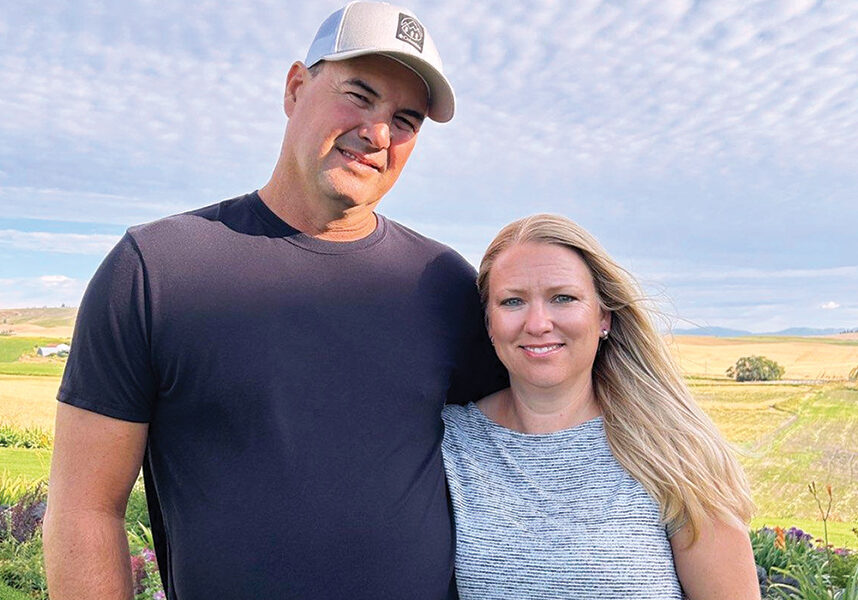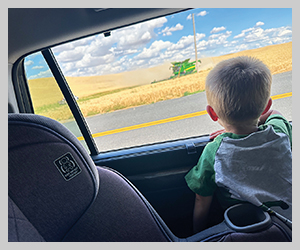
Shelly Haas is one of the landowners signed up for the Hangman Creek Riparian Restoration and Conservation Program, but she and her husband, Jim, aren’t very happy about it.
The program is funded by the Washington State Department of Ecology (Ecology) and managed by the Spokane Conservation District. The program is only open to tillage operations in the Hangman Creek Watershed that have been notified by Ecology about a potential water quality violation.
The Haas family farm is located about three miles outside of Fairfield and has less than a half mile of property on one of the Hangman Creek tributaries. They’ve been served an administrative order from Ecology, meaning the next step, if they don’t come into compliance, will likely involve financial penalties.
“We have an administrative order that says we have to have these buffers. We have to have these trees and shrubs. We have to have 300 stems per acre. We have to have X, Y, and Z, so you either pay for this yourself, and you maintain this yourself, and if you don’t have an 80% survival rate, we (Ecology) will come after you for not doing a good job. Or, sign onto this program, and we’ll pay for everything for you and give you a very small kickback,” Haas explained. “We are losing money by pulling that land out of farming. Something is better than nothing, I guess.”
While the program’s price of $300 per acre is higher than other programs that pay farmers to take land out of production, it’s still well below the income the family would normally be able to make on the approximately nine acres they are losing. Haas said, depending on the year and the crop grown, they can make from $800 to $1,200 per acre. A concern she has is being locked into a $300 per acre contract for 15 years. If additional rounds of funding are offered — and Haas believes it’s likely most, if not all the farmers in the watershed will eventually be targeted for the program — will a higher price per acre be offered to account for increased costs, inflation, and to entice landowners to enroll?
“It kind of feels like we might potentially be double hit because I do think they are only going to have to increase that price that they are giving farmers to make it more attractive to be in the program,” she said.
Haas doesn’t disagree about the need for clean water or to have farming practices that protect water quality. She’s upset over what feels like selective enforcement by Ecology against her family’s farm, explaining that as far as she knows, the only administrative order issued by Ecology since the 2018 settlement with the Spokane Riverkeeper is theirs.
“My family, my farm, happens to be one that I feel has been targeted, maybe by pure coincidence. They (Ecology) had to pick somebody to be first, but it feels like they’ve focused their energy wholly on us. It feels like blackmail, and it feels like selective enforcement,” she said. “If you look at the watershed, we are like a tributary to a tributary. Why are they not focusing on the biggest impacts first? I feel like if you start from the biggest to the smallest, it’s going to give you the biggest bang for your buck.”
The Haas family was appealing Ecology’s administrative order through the courts, but Haas said the department was threatening penalties against them and told them that unless they dropped the appeal, the family would be ineligible for any financial assistance through the riparian buffer program.
“Our choices came down to dropping our appeal and signing into the program so we were in compliance with the administrative order and avoiding penalties or pushing forward with our appeal and risk being issued penalties,” she explained.
Haas questions the science used to establish the parameters of the program, such as the minimum buffer width, and if the trees and shrubs will be able to survive the high springtime flows Hangman Creek is known for. She also questions whether the expectations around Hangman Creek and water quality are realistic. Those questions might have been answered in the appeals process.
“If the goal is to have salmon come back up this waterway, what are the unintended consequences of making that happen? Is it taking all the farmland back out?” she said, adding that the program is ultimately funded by taxpayers who should be aware of the amount of money that is being spent.
“It is my understanding the watershed has an estimated 220,000 acres of dryland farming. That is a major taxpayer project to pay farmers to pull that land out of farming and then pay SCD to prepare, plant, and maintain the buffers and trees,” she said. “Some taxpayers may also want clarification about the science, and what is necessary to protect the waterways. Taxpayers may not agree with funding this program, and if not, they need to be in contact with their legislators.”
If people want to have food on their table or bluegrass for their yards and golf courses, Haas pointed out they need farmers for that. She believes there has to be a middle ground between those pushing for more restrictions in the watershed and farmers being able to make a living and passing the farm to the next generation.
“We’ve got farmer friends who are saying, ‘I can’t believe you are even going to sign into that program,’” Haas said. “I say to them, wait until you have an administrative order. Wait until they (Ecology) are issuing penalties against you, and then tell me what you are going to do. We are making the best decision we can for our fourth generation. We have two boys in their 20s that intend to take over this farm, and I have to make good decisions with them in mind, too. It is frustrating.”












